

Introduced: 1971 (Atlas/Rivarossi version), 1985 (Con-Cor/Kato version), 1996 (Arnold/Rivarossi version) and 1997 (Con-Cor China version)
These venerable old bovines have definitely made the rounds. The original Rivarossi (Italy) version (as imported by Atlas) made its debut in 1971. This relationship lasted until around 1977 when Atlas severed their ties with Rivarossi, at which point Con-Cor stepped in and became the new importer. Circa 1985, Con-Cor contracted Kato (Japan) to produce an entirely new mechanism for the "cow" units (albeit retaining the original Rivarossi tooling for the shell and with the "calf" units remaining entirely unchanged). This version was manufactured up until around 1989, at which point Kato and Con-Cor went their separate ways. Kato "A" units can be identified by looking at the bottom of the trucks (where it says "Kato").
Along came 1996 and Arnold (now acquired by Rivarossi) reissued yet another herd of cows. The basic shells in this release were essentially the same as the old Rivarossi shells. However, some of the detailing (vis'a'vis the fuel tanks and handrails) was improved significantly. Also, the mechanism itself was completely new -

Not to be outdone, Con-Cor re-re-issued a new Chinese manufactured version of their Kato-designed SW1500 in 1997 (using much of the original Kato tooling). And for reasons unknown, Con-Cor decided to market this new release as an SW1200 rather than an SW1500.
The Con-Cor models were ultimately discontinued circa 2005 as part of Con-Cor's "The Boss Is Retiring" downsizing effort. As for the Arnolds, they similarly vanished circa 2006 when Rivarossi went bankrupt and was subsequently liquidated. Given the newer and better yard switcher options available in N scale, I doubt any of these will be particularly missed.
The convential wisdom is that none of these are accurate models. However, according to the 1971 Model Railroader review, the shells were based on prototype drawings for an SW1500 that was never actually produced (see below). So, from a certain point of view I guess they really are accurate models.
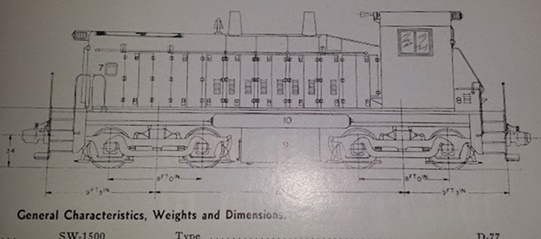
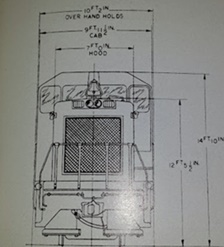
The original Atlas/Rivarossi version is a surprisingly decent runner (considering its era). All wheels provide pickup as well as propulsion (no traction tires), and throttle response is, for the most part, quite respectable. OK, on the slow speed creep side it's not quite as smooth as more modern models (mine tends to be a bit herky-jerky at really low throttle settings). Still, the fact that it even moves at all at such low currents is pretty impressive. The cab is filled with metal and the chassis itself is all-metal, so this thing has plenty of pulling heft. And although the mechanism makes use of wires to ferry current around, none of them are connected to moving parts (IE, swiveling trucks), so it's not as big of a problem as one might think -
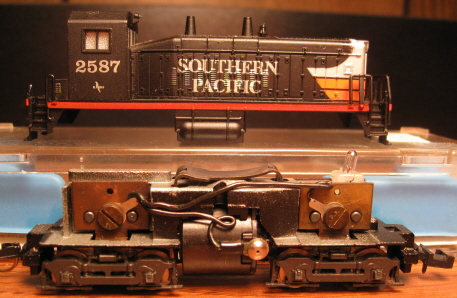
I really have to congratulate Rivarossi on the couplers and pilots. The fact that the couplers are mounted to the chassis and not the shell is virtually undetectable on these models. And the fact that they're not mounted to the trucks themselves is a flat-out miracle given the era -
The lighting is also kind of interesting - although non-directional, both ends light up when current is present (despite the single bulb). Light is transferred to the back of the loco via some sort of light-conducting plastic mounted inside the shell. On the downside, this loco is quite noisy (no doubt owing to the all-metal gears). Also, I'm told that the relatively primitive Rivarossi "can" style motor is prone to melting down. So, yeah, not exactly a model that anyone would want to run nowadays, but certainly not an embarassment either. I guess I'm in the mood to cut Rivarossi some slack here just because they managed to come up with a very innovative, non-sucking really-small locomotive design "way back when".
The dummies are a bit of a surprise - employing the exact same metal chassis as the powered units (sans the motor and gears). The upshot of all that is that a powered "calf" can be had by simply plunking a "B" shell on an "A" (IE, powered) chassis. Better still, the calf shells have light-conducting plastic pre-installed -
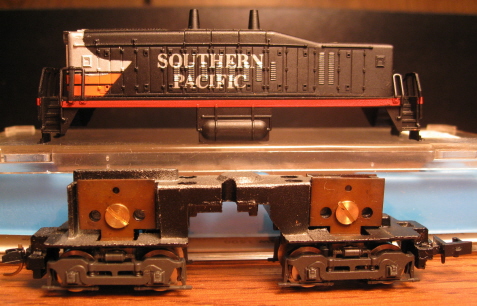
The second (Kato, 1985) version is really close to being something quite special. The shells are the same (still bearing "Rivarossi" stamps, in fact), but as you can see, the "A" unit mechanism is completely redesigned -
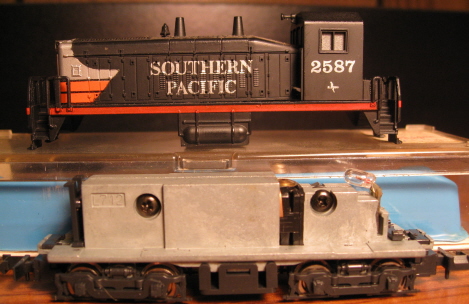
The gigantic can motor is replaced by, well, something smaller (I can't even see it, so who knows). The chassis is an all-metal, split-frame design (with nary a wire in sight). And all the gearing is now plastic. But woe unto us, one wheel on each truck has now been cursed with a traction tire (rather inexplicably, since this model weighs exactly the same as the earlier Rivarossi version). So wow, it runs super smooth and super quiet up until you hit your first turnout, at which point it'll most likely want to stall out.
Oddly enough, the dummy "B" units make use of the exact same earlier Rivarossi chassis -
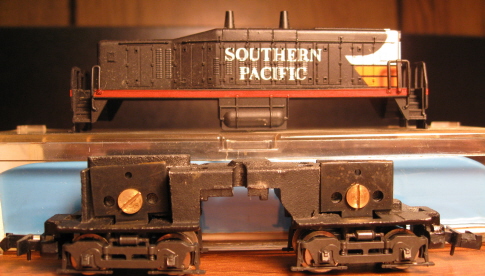
The third (Arnold/Rivarossi, 1996) version has very little in common with any of the other releases. The basic shell is the same, but the similarities pretty much end there -
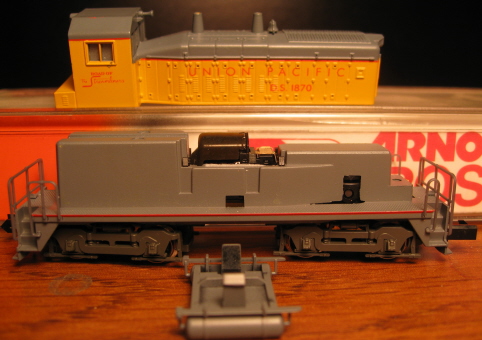
The walkway (hitherto a separate plastic piece attached to hooks on the shell) is metal and actually part of the chassis itself. The handrails are a bit smaller. The flat fuel tank (previously part of the old walkway casting) has been jettisoned in favor of a more realistic plastic fuel tank piece that hooks to the bottom of the chassis. Like the Kato mechanism, this one is entirely bereft of wiring and makes use of all-plastic truck gearing. Sadly, this locomotive has no lighting at all. More disappointingly, the formerly chassis-mounted couplers have been replaced by truck-mounted couplers (and with a much more noticeable "gigantic hole in the pilot" to accommodate them).
The internals are very much similar to Arnold's S-2 switcher - employing plastic truck gears, a small 3-pole can motor, and metal spring driveshafts (which serve both as driveshaft and worm). It also suffers from some of the same problems; if that spring driveshaft gets bent at all, these locomotives become extremely noisy. Also, the plastic axle and secondary truck gears have a weak spot (a dimple) and are prone to cracking. You'll know if yours has one or more cracked gears as it will "click" as it rolls along the track. You can determine which axle has the cracked gear by trying to turn the wheels with your fingers - if it won't turn, it's OK. If it turns, it's cracked. At least as of this 2010 writing, NWSL sells replacement geared wheelsets for these models (part #2679-6). Said wheels are low-profile, allowing one to actually run these things on Code-55 rails (as delivered, they will not).
On the plus side, this is probably the best runner of the bunch (at least as delivered). Pick-up is definitely superior to any of the other versions, resulting in extremely smooth response at all throttle levels (and better still, no problems at all navigating turnouts). On the down side, it's a bit louder than the Kato and subsequent Con-Cor/China versions (and louder still if the driveshaft is mucked up). Also, given the lack of brass worms or flywheels, it tends to suffer from Arnold "start and stop on a dime" disease.
The Arnold release is the only one with powered "calf" units (all of the Atlas/Con-Cor imports having dummy B's).
The fourth (Con-Cor/China, 1997) version is pretty much identical to the Kato version, excepting that the shells are no longer stamped "Rivarossi" and the trucks are no longer stamped "Kato" (rather, the trucks are stamped "Made in China" and the fuel tanks are stamped "Con-Cor"). On the plus side, the traction tires have been punted. On the debit side, the powered units still exhibit minor pick-up problems at slow speeds -
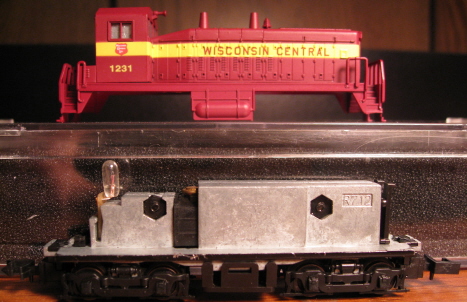
Interestingly enough, the dummy "calf" units in this release are completely new - sporting a new plastic chassis, a big-ass weight, and actual self-contained lighting -
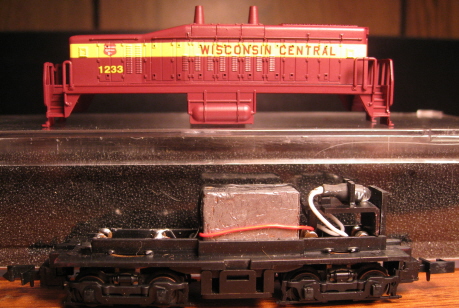
I'm told that the balkiness exhibited by the Kato design (be it made in Japan or China) is generally the result of crud collecting where the metal truck assemblies meet (and conduct current to) the metal chassis. One solution to the problem is to thoroughly clean said contacts points and then apply a bit of "Conduct-A-Lube" to the area. This will go a long way towards improving performance. In addition to keeping the truck/chassis contact points clean and Conduct-A-Lubed, the earlier Kato-made version can be made to run significantly better by simply getting rid of the traction tires. So, although as delivered these are definitely not runners, they can (with a little tweaking) be made to run respectably. OK, the shells will still be ugly, but at least they'll run.
Cow Trivia- In 1989, N Scale of Nevada released a kit to convert this SW1500 into an SP SW1200. It included a cast-metal retrofit frame and detail parts.
The shells are held to the chassis via simple friction - IE, stick a couple of toothpicks (or small screwdrivers or whatever) between the shell and the chassis and apply a bit of outward pressure to the shell sides and the shell should pull right off.
Grades: B (for the Arnold version) and C (for all the rest)
Reviewed: 5/71 Model Railroader ("The model follows the dimensions and proportions of a 1500-horsepower SW1500 unit. The overall appearance is good even though some dimensions had to be modified to accommodate large mechanical parts. The ready-to-run units come painted and lettered. The bodies are one-piece plastic castings with details cast on. The frames are cast zinc alloy. The gearboxes, truck frames, and Rapido-type automatic couplers are cast plastic... The metal wheels scale 40" in diameter and have flanges that are .035" deep. The check gauge is .320". Our sample ran smoothly. The minimum scale speed is about average for N scale equipment... Our sample pulled 20 cars on straight level track. The powered unit has a small 12-volt DC motor which drives all eight wheels... All gears are brass. The power unit's cab is filled with cast lead ballast. The unpowered unit has the same frame less weight, gears and motor. The units are available painted and lettered for SF, GM Demo, PC, UP, and Burlington. These are fine models and they fill an important gap in the roster of N scale motive power available... The model was faithfully patterned after EMD's original design for the SW1500. No units of this design were ever built. The locomotives that were actually sold are slightly different in their detailing and roof shaping. Price: $15 (powered cow), $5 (unpowered calf)")